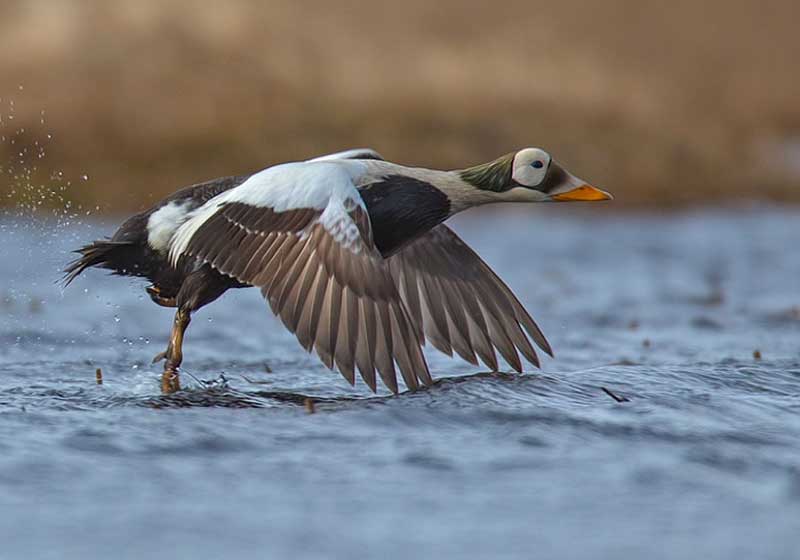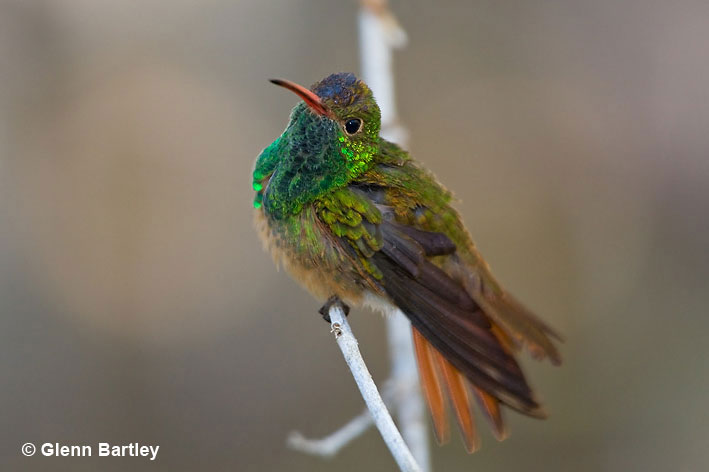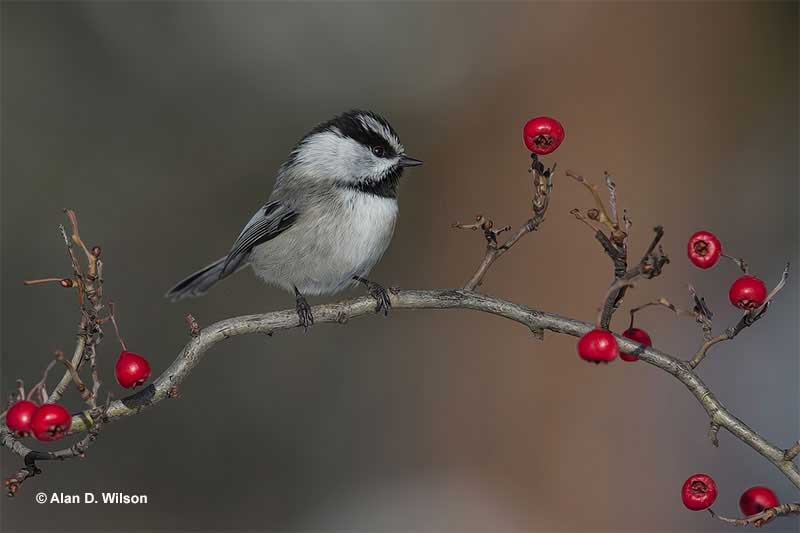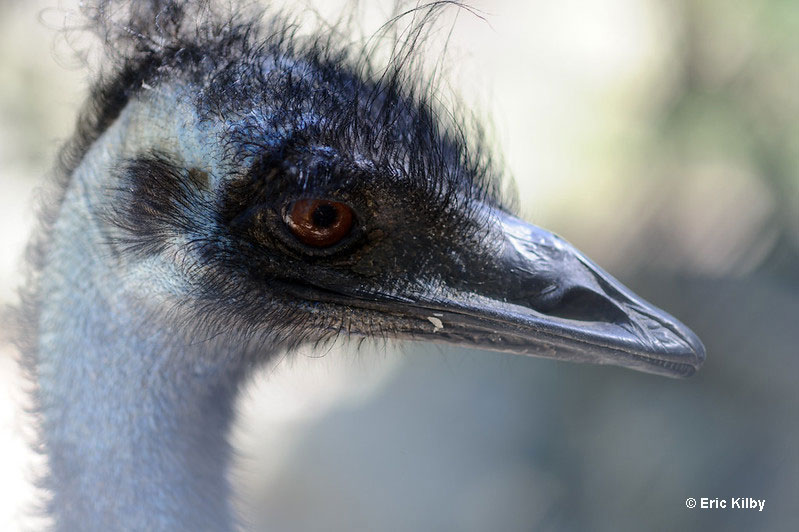What do bird names say? They can provide insights to bird habitats, colors only an artist would know, and key field marks!
A lot of bird species have names that start with the letter “S”. How did they get those names? Which live near you?
See this article to learn all about birds with names that start with “S”!
Sabine’s Gull
The elegant Sabine’s Gull was named after John Sabine, an English naturalist who wrote its scientific description in 1819. If it was named. “Elegant Yellow-tipped Gull” would give a better description of this Arctic nester.
After the breeding season, you’ll have to go to sea to watch this beauty. Sabine’s Gulls winter in the open ocean!
Sage Sparrow
The Sage Sparrow is named after its preferred habitat; sagebrush. True to its name, this handsome sparrow rarely occurs in other types of habitat. It can be a skulky and elusive bird but if you patiently look for birds in sagebrush habitats of the western USA, you’ll probably find one.
Sage Thrasher
The Sage Thrasher is another bird adapted to living in sagebrush habitats. These small thrashers are common summer birds in many parts of the western USA and southern British Columbia. In winter, they migrate to sagebrush and similar habitats in the southwestern USA and northern Mexico.
Once in a while, Sage Thrashers also wander to eastern North America!
Saltmarsh Sharp-tailed Sparrow
This species used to be lumped with the Nelson’s Sparrow and both were known as the Sharp-tailed Sparrow. However, they were eventually split into two species, and the Saltmarsh Sharp-tailed Sparrow was named after its habitat.
This species only occurs in saltmarshes on the eastern coast of the USA, and has become endangered by alteration of its critical habitat.
Sanderling
Sanderlings get their name from their beach-loving habitat and small size. The name “Sanderling” came from the United Kingdom and has probably been used there for hundreds of years.
This small sandpiper’s name refers to their habit of chasing waves back and forth on sandy beaches in many parts of the world.
Sandhill Crane
Sandhill Cranes are named after the Nebraska sandhills; a region that hosts thousands of these birds during migration. Although the huge numbers of Sandhill Cranes on the Platte River are a fantastic wildlife spectacle, these big wading birds also occur in many other parts of North America.
Watch for them in marshes and other wetlands.
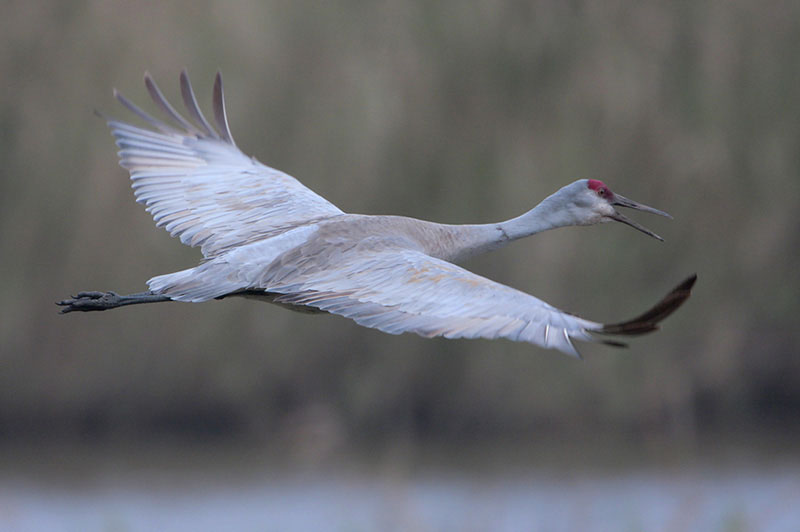
Sandwich Tern
The Sandwich Tern isn’t named after a food item that feature two slices of bread. It’s actually named after the place where early naturalists found and described it; the town of Sandwich, England.
Another good name for this handsome tern species of the Atlantic and Gulf coasts might be “Coastal Tern” or “Yellow-tipped Tern”.
Savannah Sparrow
Savannah Sparrows are small songbirds that live in a variety of open, grassy habitats. They were named after a term for open habitats but are probably easier to see on golf courses and old weedy fields than in true savannah habitat.
Watch for this common bird in a variety of open habitats.
Say’s Phoebe
This flycatcher species was named after the 19th century American naturalist, Thomas Say. We find Say’s Phoebes in wide open, dry habitats in western North America. Since they forage in the open, it’s pretty easy to see this distinctive bird.
Watch for Say’s Phoebes perched on fence posts and lone trees in open areas.
Scaled Quail
The Scaled Quail is named after the distinctive pattern of its plumage. The pattern on their neck and underparts can look a lot like fish scales!
“Scaled Quail” is a good name for this ground bird but if we named it after its habitat, we could call it “Grassland Quail”.
Scarlet Tanager
Scarlet Tanagers are beautiful songbirds with an appropriate name. Although females and winter-plumaged males don’t have any red feathers, breeding males have stunning scarlet plumage.
Their red feathers make these gorgeous birds stand out in green foliage. Scarlet Tanagers breed in deciduous woodland habitats and then fly all the way to the Amazon for the winter!
Scissor-tailed Flycatcher
Scissor-tailed Flycatchers are another bird with a perfect name. These spectacular flycatchers are related to kingbirds but are paler and are named after their long, forked tails.
Scissor-tailed Flycatchers show off their long, black and white tails and salmon highlights in open grassy habitats with scattered trees. Watch for them from Kansas to Texas.
Scott’s Oriole
Scott’s Orioles are named after 19th century general, Winfield Scott. Soldier and naturalist Darius Couch decided to honor the General when he gave the bird its English language name.
There are ongoing efforts to rename this and other birds named after people. “Yucca Oriole” is one good choice for the Scott’s Oriole and refers to its favorite habitat.
Seaside Sparrow
Seaside Sparrows are named after the only place where they occur. This dark and distinctive sparrow is completely adapted to living in coastal saltmarsh habitats.
It only lives on the eastern and gulf coasts of the USA and is fairly easy to see. We often see Seaside Sparrows foraging on the muddy ground at the edge of saltmarshes.
Sedge Wren
Sedge Wrens are small, pale songbirds with a good, descriptive name. These little birds only live in dense, grassy areas with lots of sedge vegetation.
Although they can skulk in the grass, Sedge Wrens are very vocal and can’t help but find a perch to sing their scratchy song.
Semipalmated Plover
Semipalmated Plovers have a funny name that refers to their toes! Although they have a thick black collar, there are other, similar plover species that are already named, “Collared Plover”, “Common Ringed Plover”, and “Little Ringed Plover”.
To give it a distinctive name, this species was named after the partial webbing between its toes.
Semipalmated Sandpiper
Semipalmated Sandpipers are small shorebirds named after the partial webbing between their toes. Although that’s a pretty tricky field mark to see, it does help separate this species from various other, similar sandpipers, especially ones from Eurasia.
Like a lot of shorebird species, Semipalmated Sandpipers breed in the Arctic and winter in tropical coastal habitats.
Sharp-shinned Hawk
Sharp-shinned Hawks are one of the smallest raptors in North America. They look like the larger Cooper’s Hawk but have some key differences.
One of those characteristics is the reason for their name; pencil thin, “sharp” shins. But don’t let those skinny legs fool you. Sharp-shinned Hawks use them to catch all sorts of small birds.
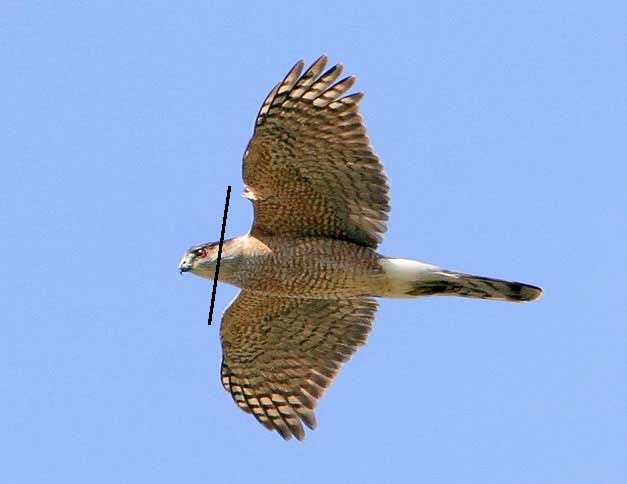
Sharp-tailed Grouse
The Sharp-tailed Grouse is named after one its key features. Like many other grouse species, this species has mottled, gray-brown plumage.
However, it also has a longish, pointed or “sharp” tail. This prairie-chicken relative lives in cold climates with dense, shrubby vegetation. Like its relatives, it also “dances” at communal leks.
Short-billed Dowitcher
Short-billed Dowitchers are named after the size of their beak compared to the related Long-billed Dowitcher. Even so, their long bill is anything but short! They use it to probe up and down in the muddy ground.
The “dowitcher” part of their name may be a derivation of another, older, New England name for the bird, the “Dutch Snipe”.
Short-eared Owl
Short-eared Owls are named after their short ear tufts. They are much smaller than the ear tufts of the related Long-eared Owl and other species.
Another good name for this pretty owl could be, “Prairie Owl” or “Field Owl”. Short-eared Owls forage for mice and small animals in open, grassy habitats.
Slate-throated Redstart
Although the “slate-throated” part of this bird’s name makes sense, the rest doesn’t. Lucky birders in southern Arizona might spot one of these tropical warblers and note that it has a dark, black-gray throat.
However, they’ll also see white in its longish tail. For this reason, this and other similar tropical “redstarts” are sometimes called, “whitestarts”.
Smith’s Longspur
The Smith’s Longspur is a handsome songbird species that breeds in the far north and winters in the eastern Great Plains. The 19th century artist and ornithologist John James Audubon named it after one of his friends, Gideon B. Smith.
Orange or Pumpkin Longspur might be a more fitting name for this pretty bird.
Smooth-billed Ani
The Smooth-billed Ani is a cuckoo species with black plumage and a big arched beak. To distinguish it from the related Groove-billed Ani, the Smooth-billed Ani was named after its smooth-surfaced bill.
Watch for this social, tropical species in brushy habitats from southern Florida to South America.
Snail Kite
The Snail Kite doesn’t look like a snail in any way. However, snails are its favorite food!
This distinctive raptor frequents freshwater marshes and other wetlands that have an abundance of Pomacea species snails. It uses its long curved beak to pull the snail out of its shell.
In North America, Snail Kites mostly occur in Florida.
Snow Bunting
Snow Buntings are small songbirds that breed in the high Arctic. Although they are black and white during the summer, most birders see their tan, white, and black winter plumage.
These distinctive birds are named after their pale coloration and winter habitat. In winter, we usually encounter flocks of Snow Buntings in snowy farm fields and other open habitats.
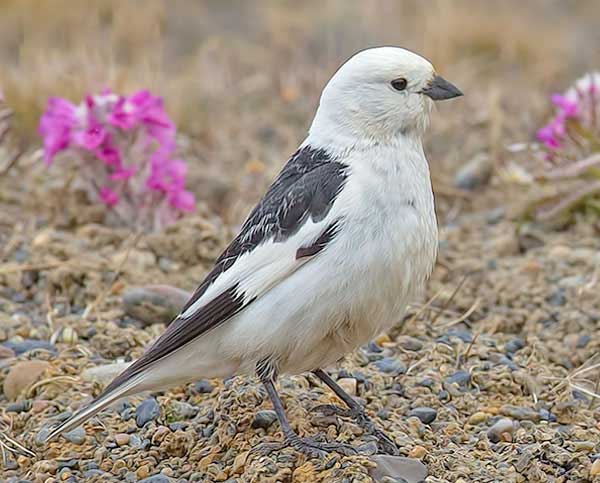
Snow Goose
The Snow Goose is named after its white plumage. Although it also has some black in its wings, this distinctive bird is one of the only mostly white goose species.
Despite their name, Snow Geese aren’t very tied to the cold stuff. While they do breed in far northern places, they winter in coastal marshes and open fields.
Snowy Egret
The Snowy Egret is named after its bright white plumage. Both adults and young Snowy Egrets have white plumage throughout the year.
These elegant wading birds breed in colonies and forage in shallow for small fish and other small creatures. It’s also easy to appreciate their plumage; Snowy Egrets live near people in many places.
Snowy Owl
Snowy Owls get their name from their white plumage. They are the only mostly white owl species, and also live in cold, and snowy places.
Snowy Owls breed in the Arctic tundra and winter in similar cold, open habitats. Once in a while, these stunning raptors fly far south of their usual range.
Snowy Plover
The Snowy Plover is a small, pale plover species that lives on beaches and inland lakes with extensive shores. This bird is named after its pale plumage. And prefers, hot and sunny habitats.
We can see this threatened bird on beaches in Florida and California, and around shallow wetlands in Kansas, western Texas, and other places.
Solitary Sandpiper
Solitary Sandpipers are named after their tendency to migrate and forage on their own. Although they can form small groups, unlike many other sandpiper species, they don’t gather in large flocks.
This species likes to forage for small creatures in the muddy margins of marshes, lakes, and other wetlands.
Song Sparrow
Song Sparrows get their name from their tendency to sing a lot. Although other sparrow species can also frequently sing, Song Sparrows grab your attention with a pronounced and cheerful song.
Expect to hear these birds in parks, big gardens, and other places with bushes and trees, especially near streams and rivers.
Sooty Grouse
The Sooty Grouse used to be lumped with the Dusky Grouse and both were known as the “Blue Grouse”. However, after they were split, the Sooty Grouse was named after its dark, blackish plumage.
This distinctive grouse only lives in coniferous forests of the Pacific Northwest and California. They occur both in coastal forests and montane habitats.
Sora
The Sora is a small rail species a bit smaller than an American Robin. This bird’s name might come from a Native American language, and could also stem from its short, rising whistled vocalization.
Go birding in summer freshwater marshes and you might hear that call. It sounds like, “two-WHEE”.
Spectacled Eider
Spectacled Eiders are big, northern ducks named after the male’s unique face pattern. The narrow black lines that form a wide circle around each eye make the bird look as if it’s wearing big glasses!
Female Spectacled Eiders show a hint of that pattern but nothing as bold as male birds.
Spotted Owl
Spotted Owls are big, dark brown owls named after the extensive white spotting in their plumage. This field mark also helps separate Spotted Owls from the related Barred Owl.
This special owl relies on old-growth forest and has become threatened by deforestation in some areas. Arizona is one of the easier places to see it.
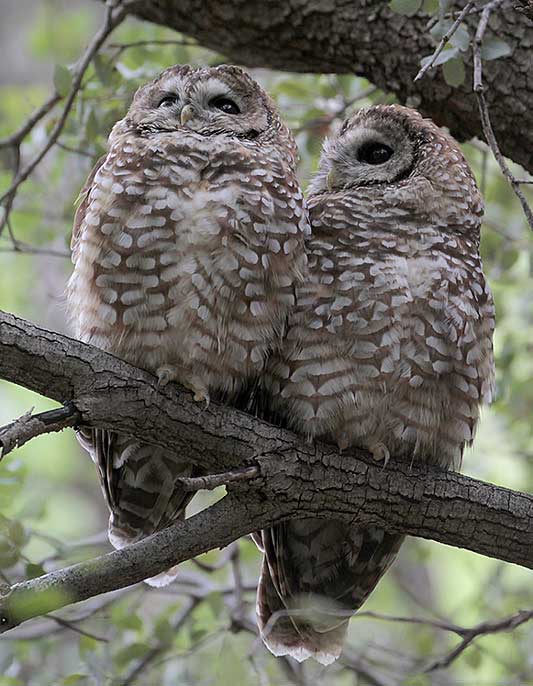
Spotted Sandpiper
Spotted Sandpipers are named after their distinctive breeding plumage. In summer, these small sandpipers show their spotted underparts as they bob up and down.
This common bird is very easy to see and identify. They frequent the shores of rivers, lakes, and other wetlands in most of North America.
Spotted Towhee
Spotted Towhees used to be lumped with the Eastern Towhee and both were known as the “Rufous-sided Towhee”. However, based on plumage differences and other factors, they were split into two species.
The ones that lived in western North America were named after their white spotted backs and became known as the “Spotted Towhee”.
Sprague’s Pipit
This plain, streaked bird was named by John James Audubon after his friend and botanical illustrator, Isaac Sprague.
To reflect its breeding habitat, a more descriptive name for this threatened species might be “Prairie Pipit”. Sprague’s Pipits breed in northern prairies from the Dakotas to Alberta, and winter from Arizona and Texas to Mexico.
Spruce Grouse
The Spruce Grouse is a chunky, often tame, chicken-like bird of the northern forests. True to its name, spruce trees are some of the more common plant species in its range.
On account of its easy-going attitude, the Spruce Grouse is an easy bird to overlook! Most birders see them on their breeding grounds in spring.
Steller’s Eider
The Steller’s Eider is named after Georg Wilhelm Steller, a German 18th century naturalist who participated in an expedition to the northern Pacific region.
On that fateful trip, he obtained the first scientific specimens of Steller’s Eiders. This smallish sea duck only breeds in northern Russia and northern Alaska, and many winter in the Bering Sea region.
Steller’s Jay
This beautiful jay species is named after the first naturalist to take notes on the species for modern science. During a 1741 expedition exploring the northern Pacific region, German naturalist Georg Wilhelm Steller only had one day to explore Kayak Island, Alaska.
He found a stunning, crested, dark blue and black jay that was eventually named after him.
Stilt Sandpiper
The Stilt Sandpiper was named after its long legs. Although some other sandpiper species also have long legs, the name stuck.
Like many shorebirds, this species breeds in cold, northern wetlands, and winters on tropical shores. It mostly migrates through central and eastern North America. Stilt Sandpipers wade in shallow water to feed.
Summer Tanager
The Summer Tanager got its name from a description made by 18th century illustrator and naturalist, Mark Catesby. He referred to it as the “Summer Red-Bird”, and it has been known as Summer Tanager ever since.
Although there aren’t any wintering tanagers, “Summer Tanager” seems to be a fitting name for this summer bird with warm red plumage.
Surf Scoter
The Surf Scoter is a hefty sea duck that breeds on shallow lakes in northern forests, and winters in coastal waters. This bird may have gotten its name from its habit of foraging in inshore waters.
Although other scoter species can also forage close to shore, “Surf Scoter” still sounds better than “Skunkhead”; another common make for it!
Surfbird
Surfbirds are chunky, almost pigeon-like sandpipers named after their preferred microhabitat. Although these birds breed on rocky alpine tundra, they mostly winter in rocky coastal habitats splashed by waves and “surf”.
One of the best ways to see Surfbirds is to look for areas of wave-washed boulders on the Pacific coast during migration.
Swainson’s Hawk
Swainson’s Hawks are big, long-winged hawks named after 19th century British naturalist and ornithologist William John Swainson. A more descriptive name might be “Prairie Hawk” or “Grassland Hawk”.
Both of these names describe the type of open habitats that these raptors prefer. They breed from Alaska to northern Mexico and east to Iowa.
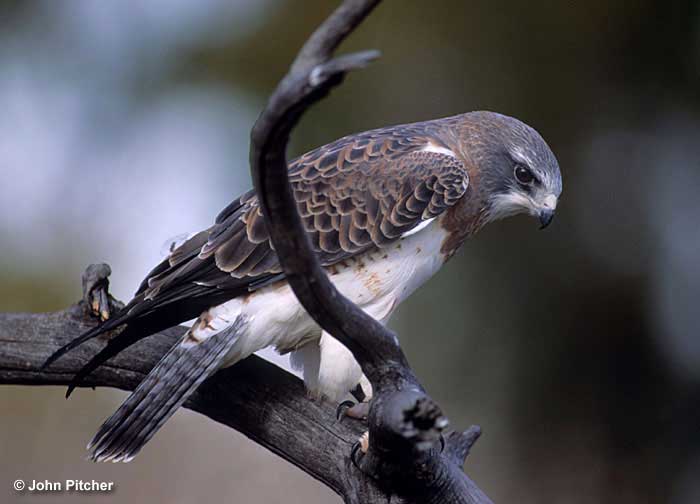
Swainson’s Thrush
The Swainson’s Thrush is another bird named after William John Swainson, a 19th century British ornithologist and naturalist.
This spotted thrush species is a common bird of the boreal zone and western mountains. A more descriptive name for it might be ”Eye-ringed Thrush”, “Buff-faced Thrush”, or “Coniferous Thrush”.
Swainson’s Warbler
The Swainson’s Warbler was described for science by John James Audubon in 1834 and named after British ornithologist William John Swainson.
More descriptive names could take into account its preferred habitat and appearance.
Two ideas are “Canebrake Warbler” and “Russet-capped Warbler”. Both of these names say more about the bird’s habits and appearance than “Swainson”.
Swallow-tailed Kite
The Swallow-tailed Kite is named after its long, elegant forked tail. The “swallow” part of its name stems from the Barn Swallow, a small bird with a similarly-shaped, forked tail.
Swallow-tailed Kites spend the summer in southern forests, especially in forested swamps and along watercourses. By late summer, they migrate south, all the way to the Amazon!
Swamp Sparrow
Swamp Sparrows get their name from their preferred habitat, and is an appropriate name for this species. These common sparrows only breed in swamps, marshes, and other wetlands.
In winter and migration, we can also see them in swamps but they also occur in a variety of brushy habitats.
Bird Families That Start With S
- Sandpipers – Small to medium-sized wading birds, many with long, fine beaks.
- Skuas – Hefty, predatory, gull-like birds that breed in polar regions and winter in the open ocean.
- Stilts – Elegant shorebirds with long, fine beaks, and elongated legs.
- Sandgrouse – Grouse or pigeon-like birds that form flocks in arid habitats of Africa and central Asia.
- Screamers – Odd, goose-like birds with loud calls that live in South America.
- Swans – Big, goose-like, white, or black and white birds with long necks.
- Sparrows – Small, finch-like birds, most with streaked brown plumage.
- Spurfowls – Medium-sized, partridge-like birds with extra claws on their legs that live in Africa and India.
- Snowcocks – Large, gray and white, grouse-like birds native to Asian high mountain habitats.
- Swifts – Fast-flying, dull-colored aerialist birds that spend most of their time catching small insects in flight.
- Sheathbills – Two species of odd, white, chicken-like birds that scavenge in and near Antarctica.
- Seedsnipes – Mottled, grouse-like birds of arid and high-elevation habitats in South America.
- Snipes – Members of the sandpiper family with rounded bodies, camouflaged plumage, and long, straight beaks.
- Sunbitterns – Heron or rail-like wading birds from Central and South America with intricate plumage and a startling sunburst pattern on each wing.
- Storm -Petrels- Small, dark, oceanic birds that pick bits of food from, and paddle their feet on the surface of the water.
- Shearwaters – Gull-sized, grayish or dark brown, oceanic birds with long, pointed wings.
- Storks – Big wading birds with long legs, a long neck, and large beaks.
- Shoebills – A huge, stork-like bird with a broad, strong beak that lives in African swamps.
- Spoonbills – Big wading birds with long legs and a long, unique, paddle-shaped beak.
- Sapsuckers – Beautiful woodpeckers that make small holes in trees to drink the sap and eat insects attracted to it.
- Seriemeas- A pair of terrestrial, raptorial bird species with long legs from South America.
- Secretarybirds – A tall, elegant and terrestrial raptor with long legs that hunts snakes and other small animals on African plains.
- Sapayoa – A dull green, flycatcher-like bird from Panama, Colombia, and Ecuador that is related to the Broadbills of Asia.
- Sharpbills – Unique songbirds with spotted underparts and sharp beaks that live in the mountains of Costa Rica and Panama, and different areas in South America.
- Sittellas – Nuthatch-like birds from Australasia.
- Shrikethrushes – Thrush-like songbirds with hooked beaks that live in Australasia.
- Shrikes – Predatory songbirds with hooked beaks, most live in Eurasia and Africa.
- Satinbirds – Stunning songbirds with glossy plumage from the mountains of New Guinea.
- Stitchbirds – A pretty black and yellow songbird that only lives on predator-free islands in New Zealand.
- Swallows – Beautiful aerialist songbirds that catch insects on the wing, many have plumages with glossy colors.
- Starlings -Rotund songbirds with iridescent plumage and sharp beaks, most live in Africa and Eurasia.
- Solitaires – Elegant, long-tailed thrushes with short beaks and beautiful, ethereal songs.
- Silky -flycatchers- Slender, long-tailed, frugivorous birds, most with crests and short beaks.
- Sugarbirds – Unique, nectivorous songbirds with long tails that only live in southern Africa.
- Sunbirds – Small nectivores with curved beaks and fantastic shining colors, they are the African and Asian counterparts of hummingbirds.
- Spiderhunters – Asian sunbird species with long, curved bills.
- Siskins – Small finches that feed on small seeds, many with yellow in their plumage.
- Spindalises – Striking, tanager-like birds mostly restricted to Caribbean islands.
- Seedeaters – Small, finch-like tanagers with stubby, rounded beaks that feed on grass seeds.
- Saltators – Cardinal-like songbirds from Mexico to South America, most with gray and olive plumage.
More in the series: Birds starting with E – Birds starting with L – Birds starting with U – Birds starting with M
